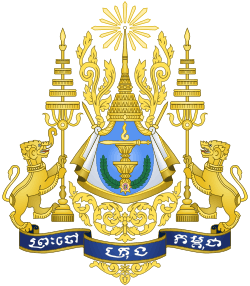Hang Thun Hak
Hang Thun Hak (Khmer: ហង្ស ធុនហាក់; August 2, 1926 – April 18, 1975) was a Cambodian radical politician, academic and playwright.
Hang Thun Hak | |
|---|---|
ហង្ស ធុនហាក់ | |
| 24th Prime Minister of Cambodia | |
| In office October 15, 1972 – May 6, 1973 | |
| President | Lon Nol |
| Preceded by | Son Ngoc Thanh |
| Succeeded by | In Tam |
| Rector of the Royal University of Fine Arts | |
| In office 1966–1970 | |
| Personal details | |
| Born | August 2, 1926 Stueng Trang, Kampong Cham, French Indochina |
| Died | April 18, 1975 (aged 48) Phnom Penh, Kampuchea |
| Cause of death | Executed |
| Political party | Social Republican Party |
| Profession | Academic Author Politician |
Life
Hak studied theatre in Paris, where he became associated with the group of radical students centered on Keng Vannsak, which included several future leaders of the Cambodian Communists. He returned to Cambodia in 1951, and spent some time with Son Ngoc Thanh's anti-colonial resistance fighters, operating from the forests in the area of Siem Reap: Hak returned to public life in 1953, shortly prior to Cambodian independence.
Under the Sangkum regime of Prince Norodom Sihanouk, Hang Thun Hak taught at the National Theatre School, where his work was central to the development of modern Cambodian theatre. He served as Director of the Royal University of Fine Arts after its founding in 1965.[1] Many of his plays, such as Thma Raom and Kanya Chareya (both dating from the late 1950s) attacked government corruption, and contained a strong element of political satire; Hak's close links with the Queen Mother, Sisowath Kosamak, helped to protect performances of these works.
The Cambodian coup of 1970, carried out by General Lon Nol, led to the end of Sihanouk's power and the establishment of the Khmer Republic. Hak was initially mooted as a leader of the Pracheachon party, a socialist party with which he had previously been involved, but eventually joined the Social Republican Party led by Lon Nol, and served as Prime Minister between 17 October 1972 and 17 April 1973.
By this time, however, the Republic had become embroiled in a bitter war against the GRUNK, a coalition between Sihanouk and his former Communist opponents, the Khmer Rouge. Despite the American policy, in force at the time, of ignoring Sihanouk in negotiations, Hak made attempts to contact him in the possibility of reaching a settlement; he also had some contact with the Khmer Rouge themselves through one of their leaders, Hou Yuon.[2] He also ensured that Queen Kossamak, Sihanouk's mother, remained protected, accompanying her to Beijing in 1973. Hak was forced to resign later in 1973.
After Lon Nol fled the capital on April 1, 1975, Hak was elected as a member of the Governing Council which sought to reach a ceasefire agreement with the Communists.
- Execution
Hak who was urged to leave Cambodia after Khmer Rouge entered Phnom Penh, refused to do so due to his love for his native country. However, he was able to get his wife, son and daughters (he had 2 daughters) out of the country and into the US. However, he remained and was eventually executed on April 18.
References
- Cody, G. and Sprinchorn, E. (eds), The Columbia encyclopedia of modern drama, Volume 1, p.583
- Clymer, K. The United States and Cambodia, 1969-2000: a troubled relationship, 2004, p.95
| Political offices | ||
|---|---|---|
| Preceded by Son Ngoc Thanh |
Prime Minister of Cambodia 1972–1973 |
Succeeded by In Tam |
